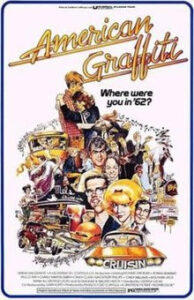
American Graffiti
Directed by George Lucas
Produced by Francis Ford Coppola
Starring Richard Dreyfuss, Ron Howard, Paul Le Mat, Charles Martin Smith, Candy Clark, Mackenzie Phillips, Cindy Williams, Wolfman Jack, and Harrison Ford
Released (US) Aug. 11, 1973
Available on various streaming services, including Netflix and Amazon Prime
I absolutely loved this movie when I first saw it in 1973. I’ve thought about rewatching it a thousand times since then. But I never did. I think I was afraid that I would be disappointed. Like experiencing again the cuisine of the restaurant where, 20 years ago, you enjoyed the best meal of your life.
American Graffiti takes place in California in the mid-1950s. It is a small town coming-of-age story. And a story about America’s coming-of-age about ten years before the era of Vietnam.
I attended middle school and high school from 1963 to 1968. So, my coevals and I were able to experience the happy, halcyon days depicted in this movie and the transition to the Vietnam/counterculture/hippie era, all in a short span of time.
And that is probably why I think of American Graffiti as a coming-of-age movie about America. As compared, for example, to Lolita, another great movie about American culture, but about the previous era, from the end of WWII to the early 1950s.
As you know, I like to think about good movies in terms of verticality and horizontality, with verticality representing how well they capture an era, and horizontality representing how well they present something deep and true about human nature.
In terms of verticality, American Graffiti is a feast of audio and visual reminders of how teenage life was back then – the drive-in diner, the school dance, the style of dressing, etc. I remembered it as being true to human nature in some meaningful way, too, but I couldn’t remember exactly how.
I got that when I watched it this time. What makes American Graffiti special in terms of horizontality is the way the relationships between the four main characters are depicted. I saw in them all the primary archetypes of teenage boy-ness that I recognized back then: the alpha guy, the beta nerd, the button-down kid, and the thoughtful, promising one that grows up to make something of himself.
But even more than that, I thought the movie nailed the underlying, complicated, invisible-to-others culture that binds together groups of young boys, who are very different from one another, as they move through adolescence by inventing and participating in their own initiation rites to manhood.
American Graffiti doesn’t present itself as important. It presents itself as a nostalgic romp. But when I saw it in 1973, I felt it was more than that. And, having seen it again, after nearly 50 years, I’m happy to say that I have the same opinion.
The movie doesn’t have much of a plot. It’s a series of anecdotes. More than could ever have happened in a single evening in a single town. But they are held together, as so many coming-of-age movies are, by the beautiful and very believable bond connecting the main characters.
It’s believable and it’s beautiful, but it is also deep. Watch it closely and you will see that all the important relationships – and several of the secondary relationships, too – skate across the fun and funny events of that imaginary evening on a very thin sheet of ice over a deep, dark lake. It is that contrast between the brightness of everything that is going on at the surface and the darkness of what is developing underneath that makes American Graffiti, for me – still, after so many years – great.
You can watch the trailer here.
 MarkFord
MarkFord